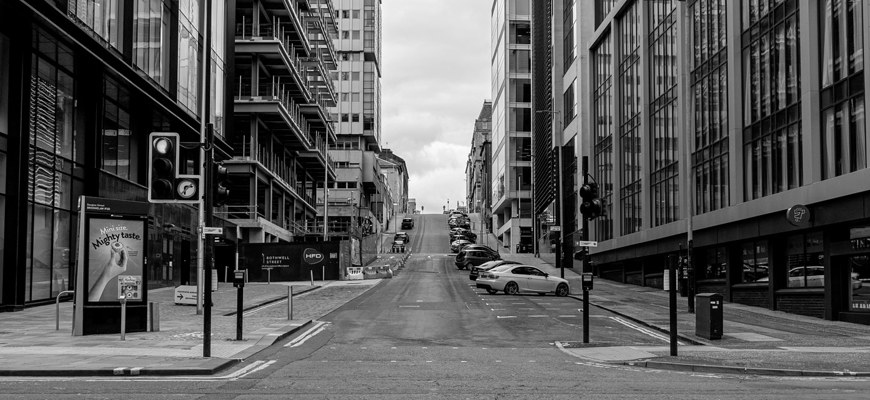Property: Scotland’s cities: is the landscape changing?

Step back a year, and who could have foreseen how COVID-19 would impact on society and the economy, including how and where people live and work? Scotland’s city and town centres, which continue to see significant commercial and residential investment in developments like Haymarket and St James in Edinburgh and Osborne+Co’s office development on Argyle Street in Glasgow, have not been immune from this shift.
Consequently, it is prudent to consider the extent to which the pandemic, and by association, demand for homeworking, will impact temporarily or permanently on how developers, investors, landlords and planning authorities view the inner city landscape.
Agents of change
There is much to consider in terms of how Scotland’s planning system could react to the current (December 2020) and predicted decrease in inner city office and retail footfall.
According to the Fraser of Allander Institute (Scottish Business Monitor), which surveyed 500 companies, over 25% expect to reduce office space permanently. It’s a sobering statistic, and one that may also reflect an anticipated rise in unemployment among Scotland’s traditionally office-based professions. It also underlines that some form of home based working is here to stay.
The pandemic aside, other agents of change will continue to influence significantly the shape of the inner city landscape. With Scotland declaring a climate emergency (April 2019), hosting COP26, and announcing a target to be carbon net zero by 2045, there has never been a greater focus on the environment and identifying sustainable ways to live, work, and travel. Notably, the UK Government has signalled its commitment to ban all new petrol and diesel cars in the UK by 2030. With some local authorities already taking steps to create a more pedestrian and cycle friendly environment, there are already signs of a shift in terms of how society will function.
Moreover, city and town centres also continue to deal with the changing nature of retail. The rise in online shopping, fuelled in part by restrictions on movement imposed during the pandemic, has adversely impacted the high street and notable traditional high street names.
In this complex picture of policy, planning, legal, economic and social change, we must also consider the stark fact that just as Government seeks to alleviate a chronic shortage of housing, there are also constraints on supply of land. These too are factors in shifting the dial in how town and city centres are planned.
Undoubtedly, these factors will all greatly influence change within our inner city landscapes. However, to understand why they present both challenges and opportunities in a planning context, it is important to recall the traditional process by which major commercial and residential space in our cities is created.
The current planning landscape
Central to any development progressing is the legislation that applies in Scotland. Planning applications are subject to the “s 25 assessment”, meaning they should be determined in accordance with the policies of the local development plan, unless material considerations indicate otherwise. Notably, any proposal is more likely to secure planning approval if it has policy support.
Interestingly, while the current planning framework attracts criticism for being slow and expensive, this same framework has appealed to institutional and overseas investors for over a decade. These parties have benefited from rental returns on their investment in major office infrastructure and, increasingly, in build to rent (BTR) developments in Scotland’s cities.
Within this context, investors and landlords will have long lease agreements in place with tenants that may include hotels or a suite of companies within one office block. There will also be break clauses, though it is beyond the scope of this piece to consider the legal ramifications for investors and landlords if financially pressed tenants seek to terminate or renegotiate a lease. However, if in response to a sudden downturn in demand for their office space, a developer or investor wishes to repurpose or effect a change of use of their office development, it is important to consider the planning and policy ramifications.
Changing a building’s use from a retail or office space to a residential model presents legal and planning issues, not least in requiring the applicant to gain planning permission. This inevitably incurs additional cost, possible delay, and no guarantee that approval will be secured. However, there is scope for optimism. Planning authorities are aware of the challenges facing town and city centres, and some are proving more receptive to providing their policy support to permit alternative use.
For example, Glasgow City Council’s City Centre Living Strategy seeks to double the city centre population by 2035. This signals a policy aspiration, and arguably a green light for developers to explore alternative uses for potentially redundant buildings. An enlightened outlook on policy will undoubtedly provide developers and investors with increased confidence that the planning authorities have a vision for their inner city areas that looks beyond the limits of traditional retail and office uses.
Differences in approach
In the above context, Scotland’s position differs from England. South of the border, the planning system provides for permitted development rights that enable an existing office development to convert to a residential development without the need to seek planning permission. Fundamentally, this offers investors and developers a streamlined and flexible way in which building types for which there is currently no market can be repurposed to meet a market demand.
Additionally, in England, developments that come forward under permitted development rights are not required to comply with space standards or to provide affordable housing. These factors may seem an attractive proposition for Scotland’s planning system.
However, there is a cost. In England, as space standards do not apply to residential developments under permitted development rights, some residential flats as small as just 90 square feet have been created in former office buildings! The same system has enabled flats to be created with only single aspect or internal windows, and in one notable case saw flats sharing the same corridor within the remaining office development. To be fair, the English system has provided some good quality housing through its process. However, the absence of rigorous scrutiny of proposals has also led to instances of poor quality development.
Consequently, I envisage little appetite for the Scottish Government to adopt a similar approach. For at the very heart of the Scottish planning system is the central tenet of place-making, whereby planning dictates that the appropriate development must be built in the right place.
2021 and beyond
It is January 2021, and in the year ahead I expect (and hope) the success of a COVID vaccine will be a gamechanger for society and the economy, though I suspect we may yet see further casualties in retail, and businesses further rationalising their office estate. In 2031, we may look back and recognise that the COVID pandemic simply served to accelerate the demand for a carbon friendly, mixed use model of office and residential development, with greater leisure and education space and a reduced retail offering.
In the months and years to come, I suspect landlords will increasingly consider whether vacant office buildings are better used as private rented developments (akin to BTR) for student accommodation, or even hotel use. For example, in inner city locations like Princes Street and George Street in Edinburgh, where the upper floors of street-front units are currently lying empty or used for storage, we may see applications to repurpose. Notably, any such successful developments would likely tip the value of these buildings on their head. For the principal value may be in residential (rented) use, with ground floor retail or leisure contributing little to the value proposition.
To support any such change of use, we will likely see planning authorities explore new policies designed to breathe life into ailing city and town centres. Developers may even seek a legislative framework similar to that in place in England.
Undoubtedly, significant challenges lie ahead to transform Scotland’s inner city landscapes successfully, not least in deciding the very purpose of the high street. It is an emotive subject, particularly in a location like Edinburgh where the retail element is a key feature of the historic fabric of the city. That said, I sense a genuine will among planning authorities to overcome the considerable challenges, and ultimately to ensure that relevant sustainable development is at the forefront of future thinking. There is a precedent. Glasgow and its riverside are already very different to its heavy industry dominated past.
The key question is the extent to which the Scottish Government and planning authorities respond to calls for further changes in how our towns and cities are structured, and how investors react. The demand for space in inner city areas will not disappear, but the purpose of that space has changed, and will continue to change.
Unquestionably, the current pandemic has accelerated changes in how citizens live in and utilise their towns and cities, and in turn the actions of the working population and visitors will influence investor, developer and landlord decisions. We must now ensure that the legal framework and planning policy are in place to enable the right opportunities to come forward, redefining the shape of our urban landscape for the next 50 years.
Regulars
Perspectives
Features
Briefings
- Civil court: Who has the final word?
- Licensing: More change to come in 2021
- Planning: new route to vary an agreement
- Insolvency: Securing creditor confidence in pre-packs
- Tax: OTS on CGT – the right fixes?
- Immigration: False economy
- Scottish Solicitors' Discipline Tribunal
- Property: Scotland’s cities: is the landscape changing?
- Four to the fore: ILC’s new faces







